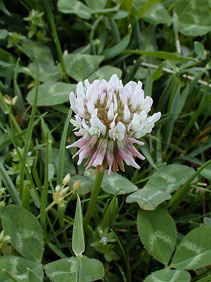WHITE CLOVER
|
 |
| File Size: 72 KB |
|
|
|
Trifolium repens L.
|
| Riley County, Kansas |
| Perennial |
| Height: 2-8+ inches |
| Family: Fabaceae - Bean Family |
| Flowering Period: May, June, July, August, September |
|
| Also Called: | | Ladino clover, dutch clover. | | Stems: | | Prostrate, creeping, rooting at nodes, glabrous to slightly pubescent; often forms mats. | | Leaves: | | Alternate, palmately 3-foliolate on stalks 2 to 8 inches long; leaflets broadly elliptic to egg-shaped or nearly heart-shaped, .4 to 1.5 long, .2 to .8 inch wide; surfaces mostly glabrous, often with pale V-shaped spot on upper surface; margins finely toothed; tip rounded to notched; stipules thin, pale, 1/8 to 2/5 inch long, at base of leaf stalk. | | Inflorescences: | | Head, nearly spherical, .4 to 1.2 inch in diameter, 40-90 flowered, terminal on stalks 2 to 8 inches long. | | Flowers: | | Individual flowers on short stalks; calyx 5-toothed, 10-nerved, glabrous; teeth narrowly triangular, unequal; corolla papilionaceous, 1/4 to 1/2 inch long, white or pinkish, turning brown; banner longer than wings and keel; stamens 10, 9 united, 1 free. | | Fruits: | | Pod, oblong-linear, 1/6 to 1/5 inch long, 2-4 seeded; seeds small, heart-shaped, yellowish. | | Habitat: | | Lawns, waste places, fields, pastures, disturbed areas, stream valleys, roadsides; clay or silt soils. | | Distribution: | | Throughout Kansas | | Origin: | | Introduced. Native in Europe and Asia, naturalized in North America. | | Reproduction: | | Seeds and stolons | | Toxicity: | | White clover can cause bloat in livestock but death is extremely rare. | | Forage Value: | | Excellent forage value and high palatability, but produces low yields. Upland game birds, wild turkeys, and small mammals consume the leaves and grouse eat the seeds. | | Uses: | | Native Americans steeped the dried leaves and took the tea to treat colds and coughs and steeped the flowers and used the liquid as an eyewash. | | Comments: | | White clover adds nitrogen to the soil. It is often used as a nectar source in the production of honey. | | | | See red clover |
|
| White clover |  | | 68 KB | | Riley County, Kansas |
| | White clover |  | | 88 KB | | Riley County, Kansas |
| | White clover |  | | 52 KB | | Riley County, Kansas |
| | White clover |  | | 114 KB | | Riley County, Kansas |
| | White clover |  | | 89 KB | | Riley County, Kansas |
| | White clover |  | | 129 KB | | Riley County, Kansas |
| | | | |
|
|
|
|
|
|